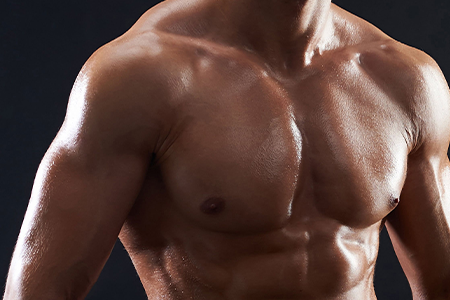That often spoken about, heard about but equally misunderstood hormone. The ‘manly’ hormone and the one that quite literally separates the men from the boys. It’s easy to think we understand the role of testosterone in so far as it is ‘what makes a man a man’, but is it really that simple? What does it actually do to a male body?
Like most hormones, it’s a chemical messenger, and in a man, is produced primarily by the Leydig cells which are found in the testicles. Whilst a small amount of testosterone is found in women (in the same way men have a small amount of estrogen) the main point of testosterone, as it is understood, is to increase the development of ‘male’ characteristics and sexual function which typically happens in puberty.
For the physical characteristics, testosterone regulates a range of areas. Bone mass, muscle growth and size, fat distribution and cellulite placement are all interlinked with testosterone. If your hormones are in balance, then a younger male will typically experience strong bones along with balanced, noticeable muscle growth and little out of place body fat. As we get older, the testosterone levels do taper off. In an evolutionary sense, this is because we are considered to be at our most fit for breeding in our younger years, and whilst older males can still perform many tasks, age does bring with it less speed and strength. In short, testosterone builds the body up and then lets it wind down later in life. This explains the link between testosterone and the male appearance; baldness and shrinkage of the sexual organs are often reported later in life, and this is because the body is not being told by testosterone to continue developing and maintaining these areas.
Sexual functions are also affected by testosterone. Libido (sex drive) is intrinsically linked to the level of testosterone in the body, which explains the link between older aged males reporting having less sex drive and less energy, as well as lower mood and erectile disfunction. It is also essential for the production of healthy, viable sperm. Without adequate levels of testosterone, men will suffer from low sperm count or will become altogether infertile. Along with this, as hormone levels start to become less regulated, men often complain about the appearance of fat around areas and breast tissue developing. This is often because testosterone is failing to tell the body how much fat to metabolise and where to place any excess.
Testosterone also plays a role in psychological functions. Mood is regulated by testosterone (which is why many people who use hormone replacement therapy in fitness experience mood swings) and so those who are experiencing low levels of testosterone may feel grouchy, or may be subject to sudden mood changes as well as feeling of lethargy or depression and low mood.
You may be forgiven for simply thinking that testosterone can be replaced and all will be well. It is certainly true that doctors can prescribe hormone replacement therapy for chronic conditions, but it is not simply a case of ingesting it and enjoying the benefits. Like anything, the body is a finely tuned machine and everything is in balance. Even in later life, the lower levels of testosterone are in line with the way the rest of the body is working. Too much testosterone can cause skin issues such acne, as well as mood swings and sleep deprivation.
The basic takeaway here is that testosterone does indeed make a man more ‘masculine’ in the traditional sense of the word, but only when it is running in synergy with the rest of the body. This is why it is important that men notice the signs of high or low testosterone; it can be regulated with a healthy diet or, if this fails, via medial intervention, but the best way to keep testosterone in check is to maintain an exercise routine and a healthy diet. This will keep the body pumping out healthy levels of testosterone for longer.


